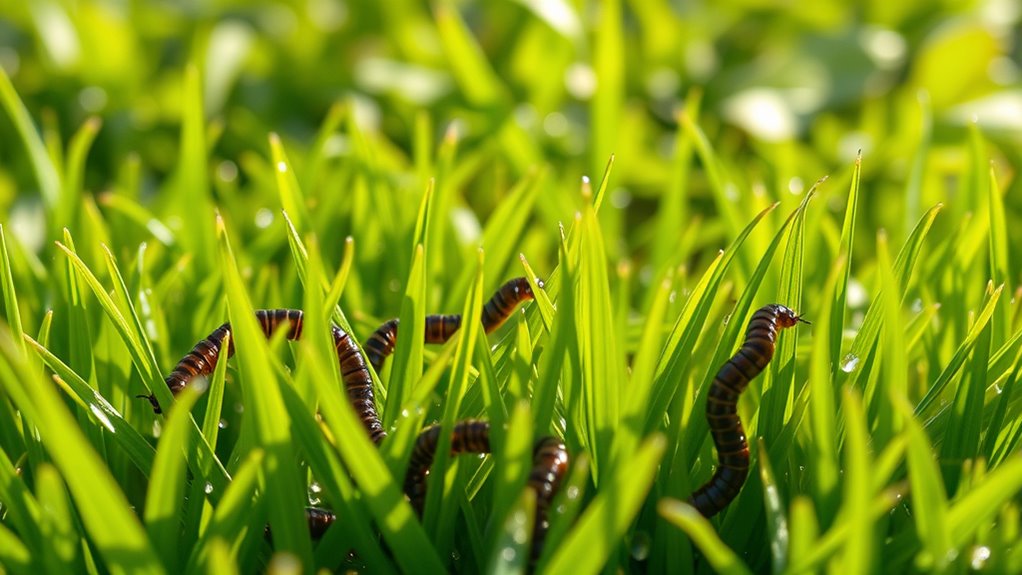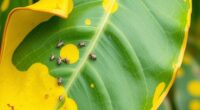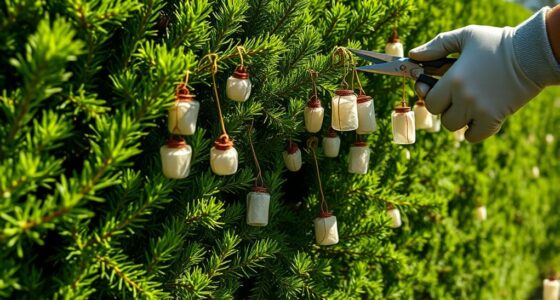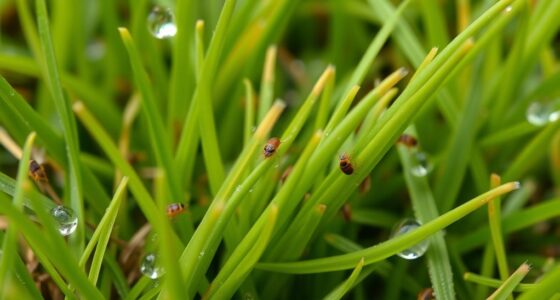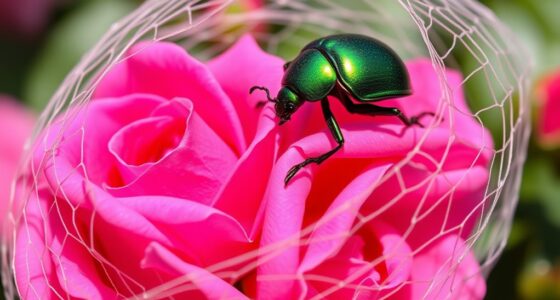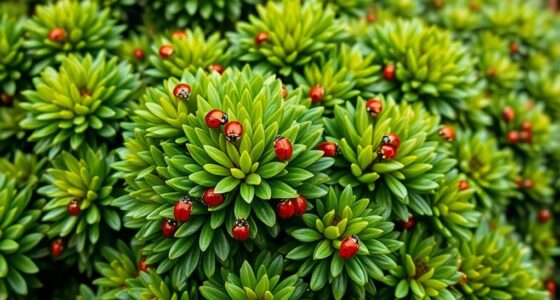To identify armyworms in warm-season turfgrass, look for their slender, elongated bodies with color variations from green to brown, often featuring distinctive stripes or spots that change with growth. Larvae range from 10 to 40 millimeters and are active mostly at night, feeding on foliage and roots, causing chewed, shredded grass, and loosened turf. Recognizing their size, markings, and damage patterns helps distinguish them from similar pests—exploring these clues further reveals more effective control strategies.
Key Takeaways
- Look for large, active larvae with distinctive black head capsules and dorsal stripes, especially at night.
- Observe turf damage such as chewed foliage, loose turf, and possible complete turf death in severe cases.
- Identify larvae by their size (10-40 mm), coloration (green to dark brown/black), and markings like stripes or spots.
- Detect silk tunnels or frass in the thatch layer for sod webworm presence; distinguish from underground cutworm damage.
- Monitor for adult moths with specific wing markings (dark stripes or spots) during migration or at rest.
Physical Features and Appearance of Armyworms

Armyworms are easily identifiable by their distinct physical features. They typically have a slender, elongated body that ranges in color from green to brown, helping them blend into turfgrass. Their camouflage strategies allow them to hide effectively among grass blades, making detection challenging. These worms also exhibit sensory adaptations, such as tiny hairs on their bodies that detect vibrations and touch, alerting them to nearby threats. Their head is small with chewing mouthparts suited for feeding on grasses, which they do voraciously. The segmented body often has faint stripes or markings that aid in their concealment. Recognizing these physical features and adaptations is vital for early identification and control of armyworm infestations in warm-season turfgrass areas.
Color Variations and Markings
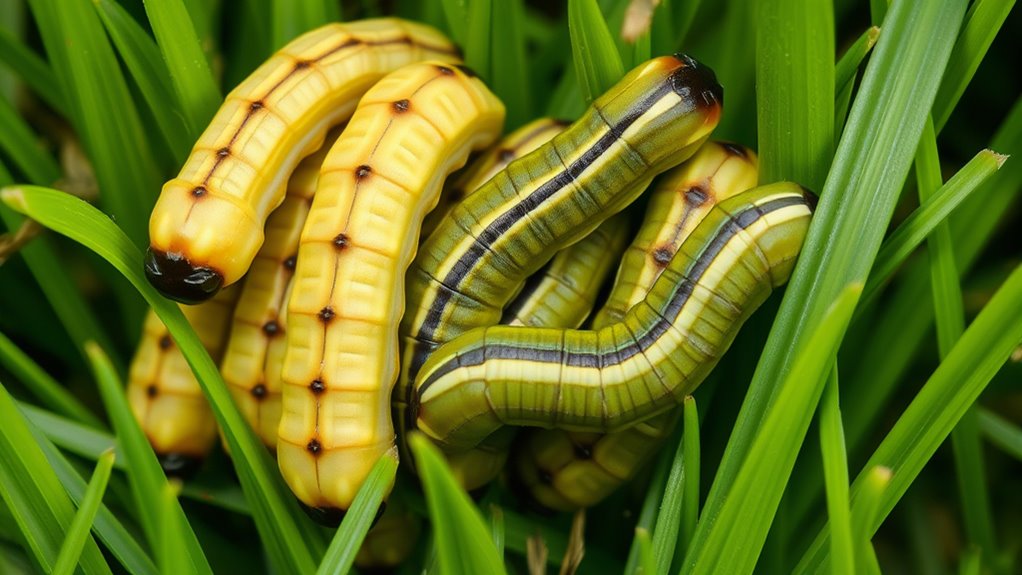
You’ll notice that armyworms show a wide range of colors, from light brown to dark green, depending on their age and environment. Their markings often include distinctive stripe or spot patterns that help with identification. As they develop, their coloration and markings can change, making it important to recognize these variations at each stage. Utilizing data-driven strategies can assist in accurately identifying and managing these pests effectively.
Color Range Diversity
Understanding the color range diversity of armyworms is essential for accurate identification, as their markings and hues can vary markedly. Their pigmentation variations span a broad color spectrum, making visual cues critical. Armyworms can display shades from green and brown to tan, often blending into turfgrass environments. Some individuals may show darker or lighter patches, adding to the complexity. To help differentiate them, here’s a quick overview:
| Color Spectrum | Typical Markings | Common Variations |
|---|---|---|
| Green | Uniform, smooth | Bright to dull |
| Brown | Speckled, mottled | Light or dark |
| Tan | Solid or with spots | Pale to deep |
| Dark Gray | Uniform or streaks | Variable |
Pay close attention to pigmentation variations for precise identification. Additionally, visual cues are essential in distinguishing armyworms from other pests with similar appearances.
Distinctive Markings Patterns
Distinctive markings and pattern variations are key to accurately identifying armyworms in turfgrass. These moths often display unique markings on their wings, such as dark stripes or spots that can help distinguish species. During mating behaviors, males and females may exhibit specific wing patterns or postures, aiding in identification. Armyworms are primarily nocturnal, so their markings are most visible when they are active at night or resting during the day. Recognizing these markings can help you differentiate armyworms from other lawn pests. Pay close attention to wing coloration, stripe arrangements, and any distinctive spots. Understanding these pattern variations enhances your ability to accurately identify the pest and implement appropriate management strategies, especially during their active, nocturnal periods. Additionally, familiarity with their behavioral patterns can improve detection and control efforts.
Developmental Stage Colors
During their development, armyworms exhibit notable color variations and markings that change as they mature. Young larvae are usually light green with faint stripes, making them blend into the turf during early seasonal behavior. As they grow, their color shifts to darker shades, often brown or black, with prominent markings like a black head capsule and distinctive dorsal stripes. These color changes help you identify their developmental stage and plan appropriate control methods. Recognizing these variations is vital, especially since mature armyworms are more destructive and harder to manage. Seasonal behavior influences their appearance, with peak activity in warmer months. Accurate identification based on stage colors allows you to implement targeted control strategies, reducing turf damage effectively and preventing infestations from escalating.
Size and Developmental Stages
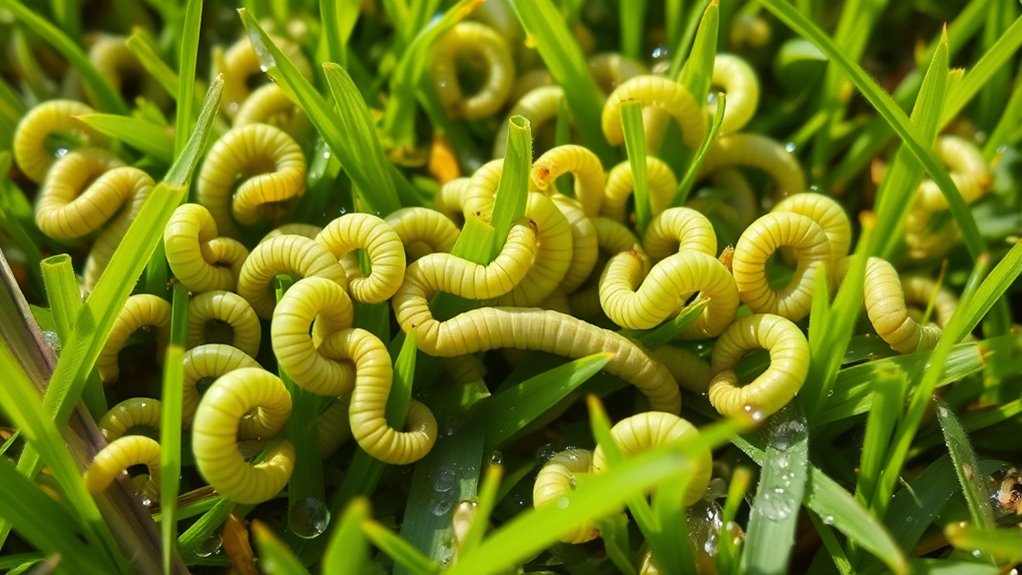
You’ll notice that armyworm larvae range from about 10 to 40 millimeters in length, depending on their stage of development. Younger larvae are smaller and have distinct markings, while older ones are larger with more defined features. Recognizing these size differences and stage markers helps you identify their growth progress accurately.
Larval Size Range
Larval size varies markedly across different developmental stages of armyworms, typically ranging from about 2 to 30 millimeters in length. Early instars are small and delicate, while later instars grow considerably larger. As larvae develop, their size can influence their behavior and habitat preferences, especially in relation to soil moisture levels. Larger larvae tend to inhabit areas with higher soil moisture, which supports their feeding needs. Additionally, noise attraction may occur more often with larger larvae, as they become more active and easier to detect. Feeding behavior also varies with size, with larger larvae consuming more and potentially causing more damage to turfgrass.
- Smaller larvae are less mobile and harder to spot
- Larger larvae are more active and visible
- Soil moisture influences larval habitat choice
- Noise attraction increases with larval size
Stage Identification Markers
Identifying armyworm developmental stages relies heavily on size and physical markers that change as the larvae mature. Younger larvae are small, pale, and lack prominent markings, making them harder to detect. As they grow, they develop distinctive features that signal their stage, aiding in timely decisions about chemical control or biological control options. The table below summarizes key markers:
| Stage | Physical Markers |
|---|---|
| Early instar | Small size, pale color, minimal markings |
| Mid instar | Larger, darker, with faint striping |
| Late instar | Largest, robust, with prominent markings |
| Mature | Fully grown, ready to pupate, darker coloration |
Recognizing these markers helps you target treatments effectively, minimizing economic loss while supporting integrated pest management.
Identifying Larvae vs. Adults
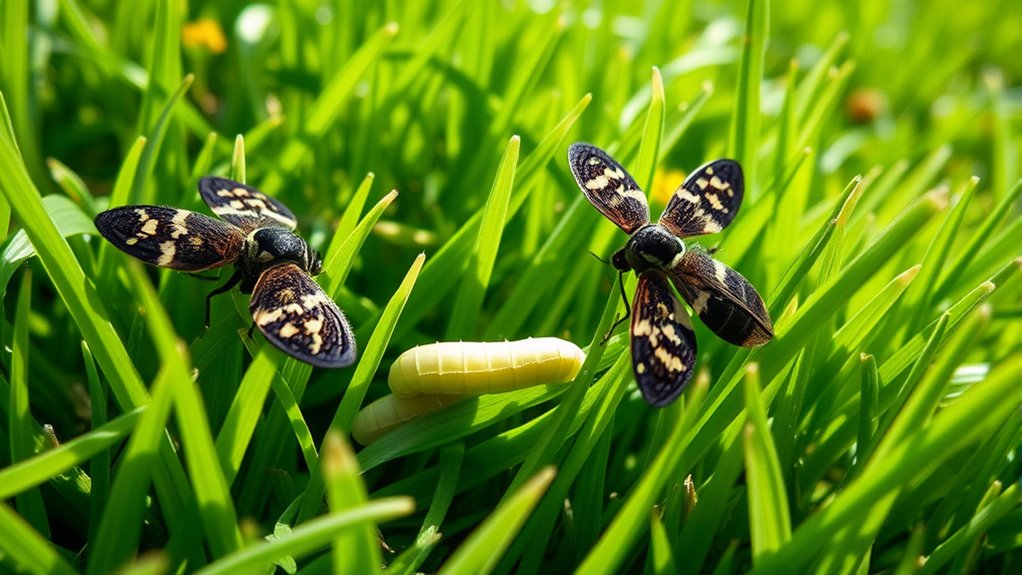
Distinguishing between larvae and adult armyworms is essential for effective pest management in warm-season turfgrasses. Understanding their different stages in the life cycle helps you select appropriate control methods. Larvae are usually smaller, with a cylindrical body and limited mobility, while adults are moths with broad wings. Recognizing these differences ensures accurate identification and timely intervention. Proper identification also helps prevent unnecessary treatments and supports integrated pest management, ensuring sustainable control strategies.
Typical Damage Signs in Turfgrass
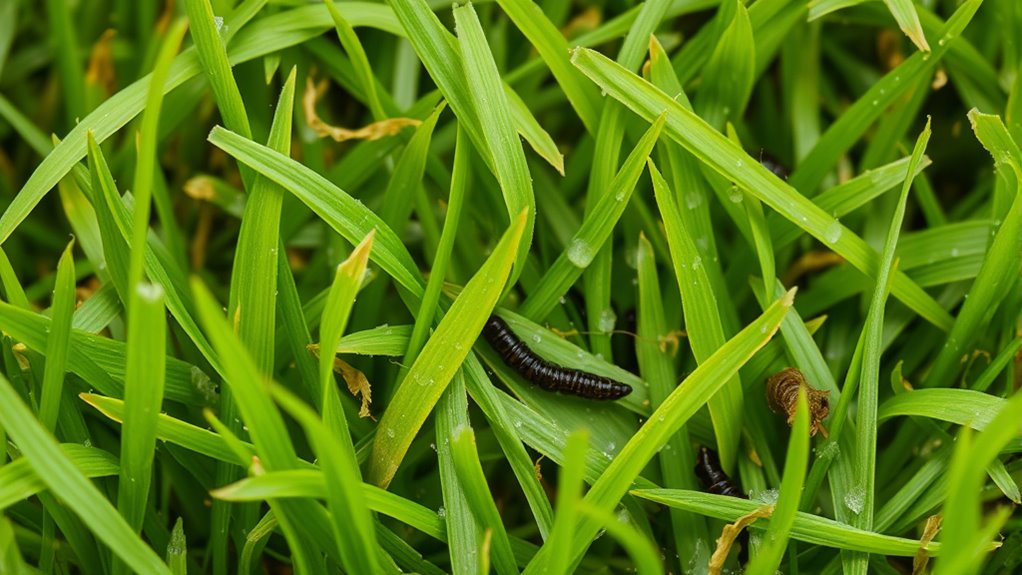
Effective pest management begins with recognizing the visible signs of armyworm activity in your turfgrass. Look for areas of turf damage, such as thinning, browning, or bare patches, which indicate feeding activity. You may notice irregular patches where the grass appears chewed or shredded, especially near the base. Since armyworms feed on the foliage, damage typically starts at the surface but can also involve root feeding, leading to weakened plants and further decline. Root feeding causes the turf to feel loose or spongy when stepped on, and the grass may easily pull up. In severe cases, turf may die back completely. Early detection of these damage signs allows for targeted intervention before infestations spread extensively.
Patterns of Infestation and Movement
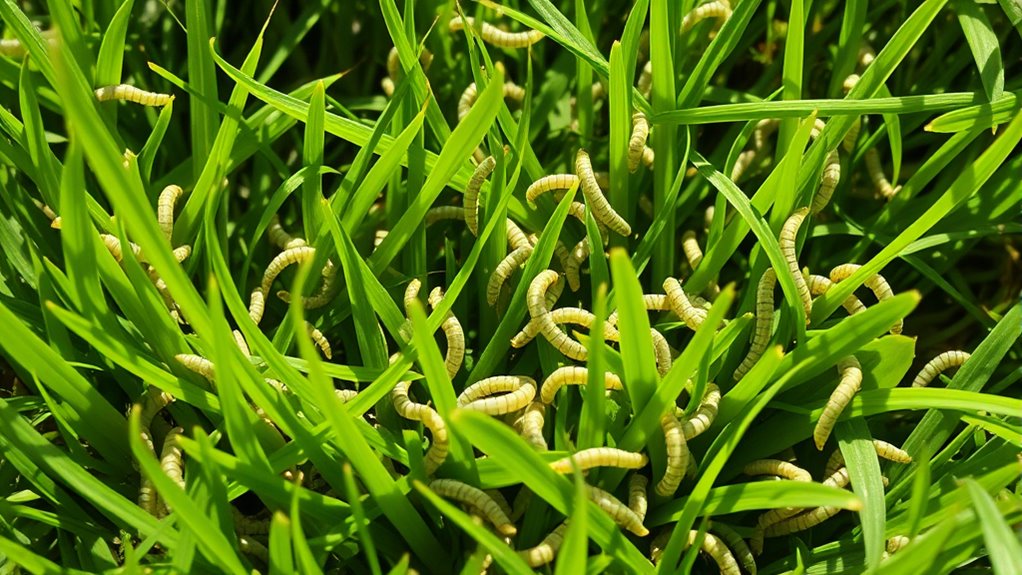
Armyworms tend to infest turfgrass in localized hotspots, but their movement patterns can lead to rapid, widespread damage. Understanding their migration patterns helps predict outbreak areas and timing. During warmer months, adult moths fly significant distances, spreading larvae across multiple sites. Their overwintering behavior influences where populations originate each season, often in protected areas or debris. You should monitor nearby fields and natural shelters for early signs of movement. Presence of mold or other spoilage signs in organic debris can indicate potential overwintering sites. – Migration patterns enable rapid dispersal across turf areas – Overwintering sites serve as sources for new infestations – Larvae can crawl or be carried by wind to adjacent turf – Adult moths migrate at night, increasing spread potential
Environmental Conditions Favoring Armyworm Activity
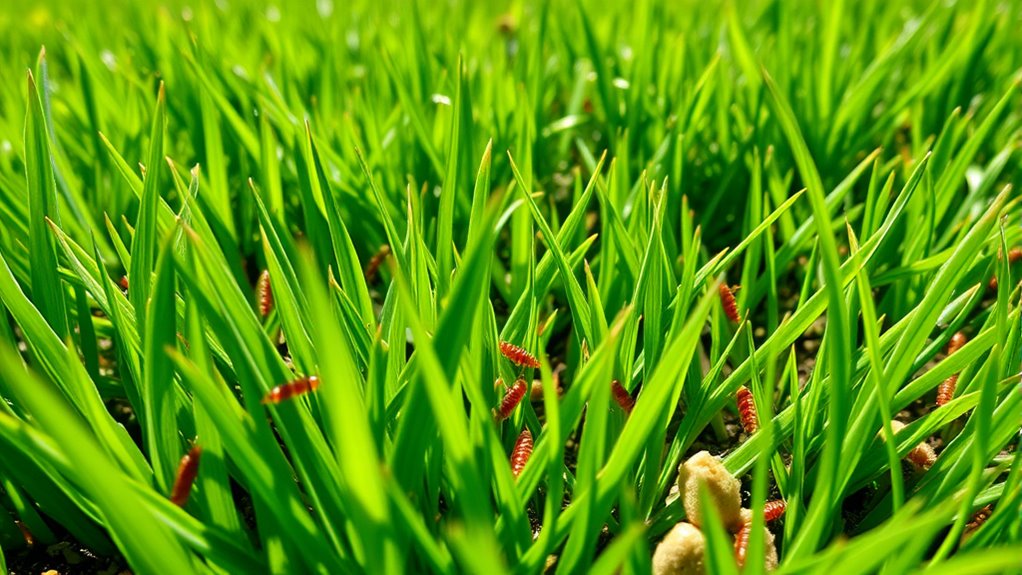
Environmental conditions play a vital role in determining armyworm activity and the severity of infestations. High soil moisture creates ideal conditions for egg laying and larval development, increasing the likelihood of outbreaks. When the soil stays moist, armyworms find it easier to access roots and organic matter, promoting their growth. Additionally, canopy density influences armyworm activity; dense foliage offers shelter from predators and harsh weather, encouraging larvae to feed and develop. In thick canopies, the microclimate remains humid and warm, further accelerating their life cycle. Conversely, dry or sparse canopies tend to suppress armyworm activity, limiting their spread. Monitoring soil moisture levels and canopy density helps you predict potential outbreaks and implement timely management strategies to protect your turfgrass. Maintaining proper GMC tuning can also optimize your turf equipment’s performance, ensuring efficient application of control measures and reducing pest impact.
Differentiating Armyworms From Similar Pests
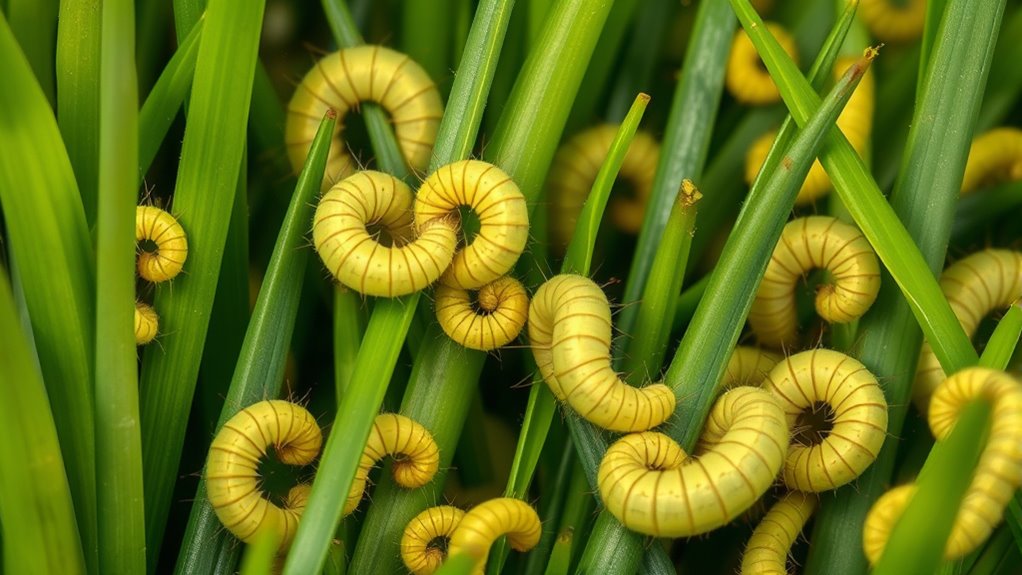
Accurately identifying armyworms requires distinguishing them from other similar pests that often appear in turfgrass, such as cutworms, sod webworms, and black cutworms. These pests can look alike but differ in behavior, appearance, and damage patterns. To tell them apart, focus on larval size, coloration, and feeding habits. Recognizing these differences helps you select effective pest control methods and implement targeted turfgrass management strategies.
- Armyworms are typically larger and more active during nighttime.
- Sod webworms create silk tunnels in the thatch layer.
- Black cutworms prefer underground feeding and cut young plants at the base.
- Proper identification minimizes unnecessary pesticide use and improves control success.
Frequently Asked Questions
How Can I Prevent Armyworm Infestations in My Turfgrass?
To prevent armyworm infestations in your turfgrass, you should start with regular monitoring for signs of damage or pests. Using biological controls like beneficial nematodes can help reduce populations naturally, while chemical treatments can be effective if infestations are severe. Keep your turf healthy through proper watering and mowing, as healthy grass resists pests better. Combining these methods offers the best defense against armyworms, minimizing damage and maintaining lush turf.
Are Certain Turfgrass Species More Susceptible to Armyworm Damage?
Some turfgrass species are more susceptible to armyworm vulnerability due to their growth habits and tissue composition. For instance, Bermuda grass and St. Augustine grass tend to be more vulnerable because they provide easy feeding material for armyworms. Understanding turfgrass susceptibility helps you identify high-risk areas and implement targeted pest management strategies. Choosing less vulnerable species or maintaining healthy, vigorous lawns can also reduce your turf’s overall vulnerability to armyworm damage.
What Natural Predators Help Control Armyworm Populations Naturally?
You can naturally control armyworm populations through biological control by encouraging beneficial insects. Beneficial insects like parasitic wasps and predatory beetles prey on armyworms, helping reduce their numbers. To attract these helpful predators, you should avoid broad-spectrum insecticides and plant diverse, native plants that provide shelter and food. Promoting a healthy ecosystem supports biological control, minimizing the need for chemical treatments and maintaining your turf’s health.
When Is the Most Effective Time to Treat for Armyworms?
The most effective time to treat for armyworms is when pest monitoring indicates their presence, typically early in their development. Timing strategies involve regularly inspecting your turf for signs of feeding or larvae, so you can apply control measures promptly. By staying vigilant and monitoring closely, you ensure you’re treating at the right moment, which maximizes effectiveness and minimizes unnecessary pesticide use. Early intervention is key to managing armyworm outbreaks successfully.
Can Armyworms Cause Long-Term Damage to Turfgrass Health?
Did you know that severe armyworm infestations can cause up to 50% turf loss? Yes, they can cause long-term damage to your turfgrass health if left untreated. Armyworms feed on grass blades, weakening the turf’s resilience and making it more vulnerable to drought and disease. Prompt treatment helps preserve your turf’s vigor, ensuring it recovers fully and maintains its lush appearance over time.
Conclusion
So, now you’re a turfgrass detective armed with armyworm knowledge. Watch out for those sneaky caterpillars with their tricky markings and voracious appetites. Remember, spotting damage early keeps your turf from turning into a battleground. After all, who needs a lush lawn when you can have an army of tiny invaders waging war? Stay vigilant, stay clever—and maybe, just maybe, keep the armyworms at bay before they write their own turf saga.
